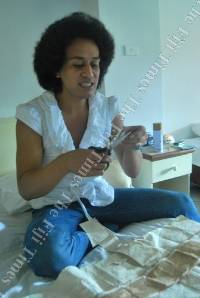Fumaru Fatiaki
From Fijitimes Online (1 September 2011) A touch of creativity by Kelera Serelini
SINCE the first Hibiscus Festival or Adi Senitoa, every winner has donned a crown or tiara or even flowers in their hair which symbolised beauty, love and compassion. And donning the "crown" was every contestant's ultimate dream; it meant that one would be carrying the title of Miss Hibiscus for a whole year, involving herself in community work and also becoming an ambassador for Fiji. And yes, there is no Adi Senitoa or a Hibiscus queen without a proper tiara or crown on a queen's head. But have we ever wondered about the creative hands behind the headbands that appear on the front page of newspapers following the crowning of a new festival queen? My intuition led me to a very talented young man who has been creating these beautifully crafted crowns for the Vodafone Miss Hibiscus winners, 29-year-old Fumaru Fatiaki from Oinafa, Rotuma. Sitting on a bed with a half made sash, wearing a simple blue pair of jeans and a white shirt, Fumaru put the final touches on the sashes for this year's Adi Senikau pageant while he spoke about the eight crowns he made especially for the Vodafone Hibiscus Festival Prince, Princess, King and Queen winners. "I actually made two tiaras for the Hibiscus queen winner and the reason was because as an artist, I wasn't satisfied. I felt the queen's crown had to be the best," he said. "The crowns were made of masi flowers, mother of pearl shell and magimagi. I used all our natural resources to create them and this year, I was fortunate to have the help of Ana, the owner of Kingdom Closet and many of my friends ù they have been very instrumental in putting all this together." For the charity queen, Fumaru said the crown had to be extravagant considering that this particular queen had raised the highest amount for the charity chest. "It was made of red and white masi flowers and freshwater pearls were secured beautifully on the edge of the flower petals tracing the curve design of the crown and creating a pattern inspired by the Vodafone logo at the centre. My aim was to create something that the main sponsor would be proud of as well. "For the King, the materials were manly. "I used magimagi, a pig's tusk in the middle and created the crown with bones." Aside from the crowns and tiaras, Fumaru designed the winning sash for all the categories including Adi Senikau. And it took him only three weeks to complete all the crowns. Despite the tight deadline, Fumaru says he still enjoys creating ornaments and wearable arts that people can relate to. "I just want them to love it and when they're wearing it, they must feel proud that these are creations made in their own country, using our natural resources." Fumaru was also behind the Malaga performance costumes in 2008, which he designed and tailored to fit 120 members. He also designed the Monfort Boys Town costumes for the 2006 Tadra Kahani and loves to make hair flowers, hats, bouquets and clothing art with masi flowers and shells. So where did all this love for the creative arts start? "I used to spend a lot of time on the farm with my dad and it was from there that I realised the beauty of our natural environment and how we can make use of this to create ornaments, jewellery and so forth. "My creative experience was further developed when I worked for Kapui Creations and with Rosi Semisi. "I was also a dancer with the Oceania Dance group and Allan Alo, and I sang for Malaga. Being involved in those activities sort of brought out that creative side in me. "I began to use my talent to earn money and now I am so glad that people like Igelese Ete keep encouraging people like me to advance in the community and make use of our creativity in other sectors like fashion and now, the pageant." In terms of his future plans, Fumaru hopes to continue designing wearable arts and would like to be involved in more charity work as well seeing that the gay community are accepted and respected. "I have been involved in dressing women and men, looking after children and homes. "It would be great to see that the gay community and people who have contributed to society are accepted for the work we have done, especially in fashion and pageants such as the Hibiscus Festival. "By developing the Adi Senikau pageant for these young people to be able to showcase their talents and knowledge, we can also contribute immensely in our various communities," he said.
|
